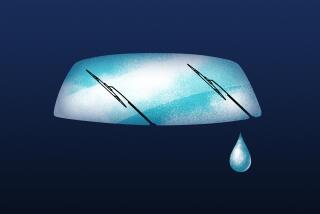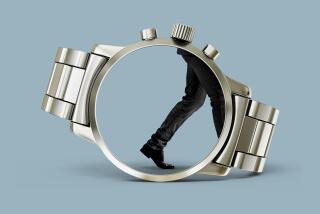A Collector’s Item in Stainless Steel : DeLorean owners hope that some day the cars will be worth more than they cost. For now, they’re just enjoying the ride.
The throaty rumble of the engine isn’t all that different from, say, a Miata’s. The casual passerby might not distinguish the car from, say, a Nissan ZX.
But then the doors open not out like a normal car’s, but up, like the wing of a gull poised for flight, and the back of the car shows the stylized three initials: DMC. Ten years after it went on sale, seven years after the sensational drug trial of its flamboyant creator, the DeLorean motor car cruises down the highway of cult stardom.
How much do people like the car?
--Carl Roos of Orange has a “For Sale” sign on his, but he parks it around back, so no one will see the sign.
--John Truscott of Santa Barbara won’t drive the two-seater unless it’s spic-and-span. And because Santa Barbara bars washing cars in most cases because of the drought, he doesn’t drive it.
--Jack Balderston of Irvine spent more than a year on the waiting list to buy his in 1981 and drives it still. Balderston’s wife, Phyllis, says they’re seeing “a new generation” of owners and enthusiasts.
Of course, the car’s starring role in the “Back to the Future” movies hasn’t hurt, either. Owners report getting new glances of recognition since the movies hit the screen.
Truscott said he drove one of his two DeLoreans to Chicago not too long ago. “I got into some of these rural areas, and any time I stopped for gas or anything, we had an instant crowd.”
Many owners are hoping that, because they don’t make the cars any more, some day they’ll be worth more than they paid--though that day seems a bit down the road.
Don Eitleman, an owner of the DeLorean Motor Center in Garden Grove, says that cars costing $25,000 or so new now go for “anywhere from $22,000 to $28,000” if they have low mileage and are “real clean.” A parts supplier in Ohio says prices seem to run $12,000 to $23,000, depending on the year and condition.
Only 8,583 of the stainless-steel-bodied cars were made, but parts aren’t as much of a problem as might be expected, considering the last new DeLorean rolled out the door in 1982.
Eitleman, who usually has a dozen or more cars in his shop awaiting everything from tuneups to post-accident surgery, says it’s just about impossible now to get some parts for the fuel system. Rack-and-pinion assemblies are available, but his garage rebuilds their own rather than buy new ones because he thinks the quality is better. Left fenders are “very scarce,” too, for some reason.
Eitleman worked for the DeLorean company at its Santa Ana offices, where the cars that had been produced in Northern Ireland were prepared for sale in the United States.
Reflecting the political problems of Northern Ireland, Catholics used to enter the plant from the north side, Protestants from the south. The assembled cars were shipped from a dock next to the shipyard where the Titanic was built.
When the cars arrived in the United States, many of the parts were “out of shape,” said Eitleman, because the inexperienced Northern Ireland work force “didn’t know how to build a car.” More than 50 workers were sent from the plant to Santa Ana for further training, which caused one unexpected problem.
“Every break they had, they were out there in the sun,” Eitleman remembered, and it took days for the men to get over their sunburns. After that, the company bought them hats, sunglasses and suntan lotion.
When the cars did run right, there were other problems. The recession cut into aficionados’ ability to buy a $25,000 car. There were no separate dealerships, so a Chevrolet or Mazda dealer was more likely to concentrate on selling the basic product than the new car. The company ran low on cash.
It was the cash flow problem that led to the nadir of the car, due to the problems of the man whose name was on the bumper.
Desperate for cash, for with the British government having already taken over the Northern Ireland plant for non-payment of debts, DeLorean was arrested in a hotel near Los Angeles International Airport on charges of conspiring to distribute $24 million worth of cocaine. An FBI videotape showed him lifting a bag of cocaine from a suitcase stuffed with the drug and proclaiming: “It’s good as gold, and just in the nick of time.”
The British government closed the plant the day of DeLorean’s arrest, and although he was acquitted of the cocaine charges two years later, car owners had to put up with a lot of grief.
“People would drive by, kids mostly, and say, ‘Where’s your snow,’ ” Phyllis Balderston said. “For a while I called it my snowmobile.”
A friend of Carl Roos managed to unearth an old “Coke Is It” bumper sticker, which Roos slapped on his car.
DeLorean moved to New York City, where he has talked about possible new business ventures from time to time, none of which has come to fruition.
Eventually his newsworthiness, and the cocaine jokes, stopped and “Back to the Future” refurbished the car’s image, to the delight of the owners who bought them as much for investment as for the ride.
Pat Parr, for instance, bought a 1982 DeLorean with about 3,000 miles on it, kept it for eight years and 2,000 more miles, and sold it last month for a price he didn’t want to divulge.
“I’m going to pick up a couple more,” said Parr, an engineer who lives in Orange and is also the owner of a 1938 Chevrolet, a Bentley and a Crosley car. “I’m going to buy some damaged ones, because the damaged ones are going on the market kind of low now. Seeing as how I do my own work, I think I’ll come out OK.”
Eitleman said he and two other garage workers tracked down two DeLoreans that had never been registered, finding them in Lake Havasu, Ariz. The garage bought them, fixed them up and sold them to a Japanese buyer for $35,000 apiece.
Most DeLorean owners use it “as a second car and drive it only on weekends,” said Eitleman. They’re hoping “they’ll shoot up to $500,000.” He drives one himself and thinks that some day “they might go up to $80,000.”
Virgil Rush, an Irvine private investigator who didn’t like the car when he saw it but fell in love with it after driving one, has a different motive for keeping his, “a little ego.”
“What’s really a good feeling is when you’re driving down the freeway and a guy comes up in a ‘Vette and he paces you and looks at you and you know the ‘Vette costs more than the car I’m driving, a whole lot more.” Also nice was the time the silver and black Rolls-Royce rolled past him on the freeway and he saw the passengers pointing at the DeLorean and oohing and aahing.
Jack Balderston read about the plans for the car back in the late 1970s, tracked down DeLorean’s headquarters in New York, found out who the local dealers were, and put his name on a waiting list. A year and a half later, in 1981, he got the car.
“I thought to myself, either this will be a success and . . . eventually (the car) will be worth money, or it will go belly up, and it will still be worth something.”
Eighty-six-thousand miles later, Jack and Phyllis figure they can’t get their original investment back, but they love the car anyway. Both are officers in the DeLorean Owners Assn., a nonprofit group based in Los Angeles with chapters across the country and about 50 members in Orange County.
The association has its own slick quarterly magazine and takes part in rallies, parades and other get-togethers. The St. Patrick’s Day parade in Mission Viejo usually features several DeLoreans, one after another, gull-wing doors open and up, Irish music playing on the car stereos.
The open-door look was popular at Don Steger’s wedding, too.
Steger is co-owner of the DeLorean Motor Center. When he was married three years ago, he and his bride emerged from the church to walk between two rows of DeLoreans, each with eight cars.
Steger put his bride into his own DeLorean, got behind the driver’s seat of the two-seater, and lowered the doors to the closed position. Two by two, the cars behind Steger lowered their doors, too, in an automotive ballet in stainless steel.






